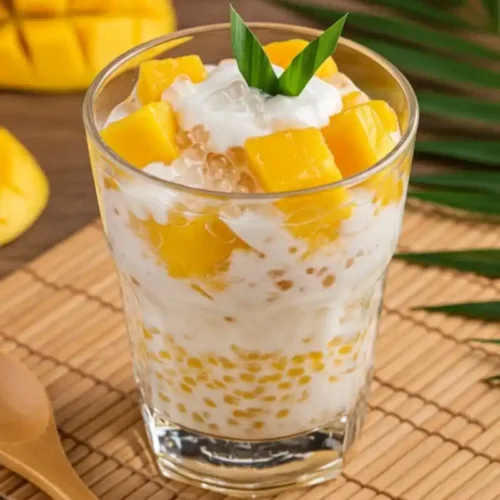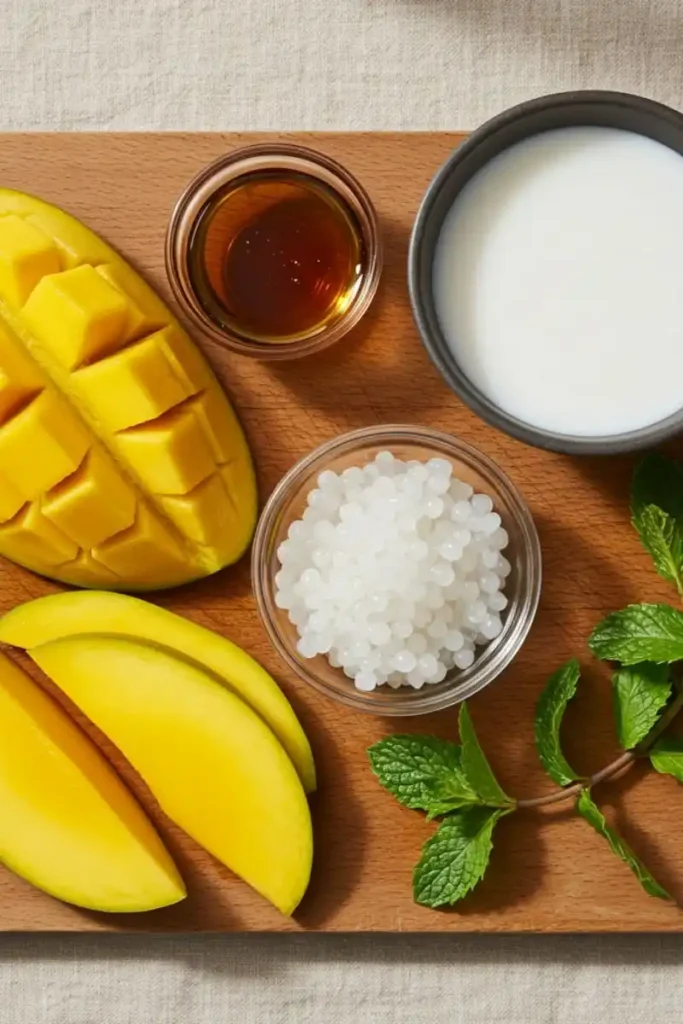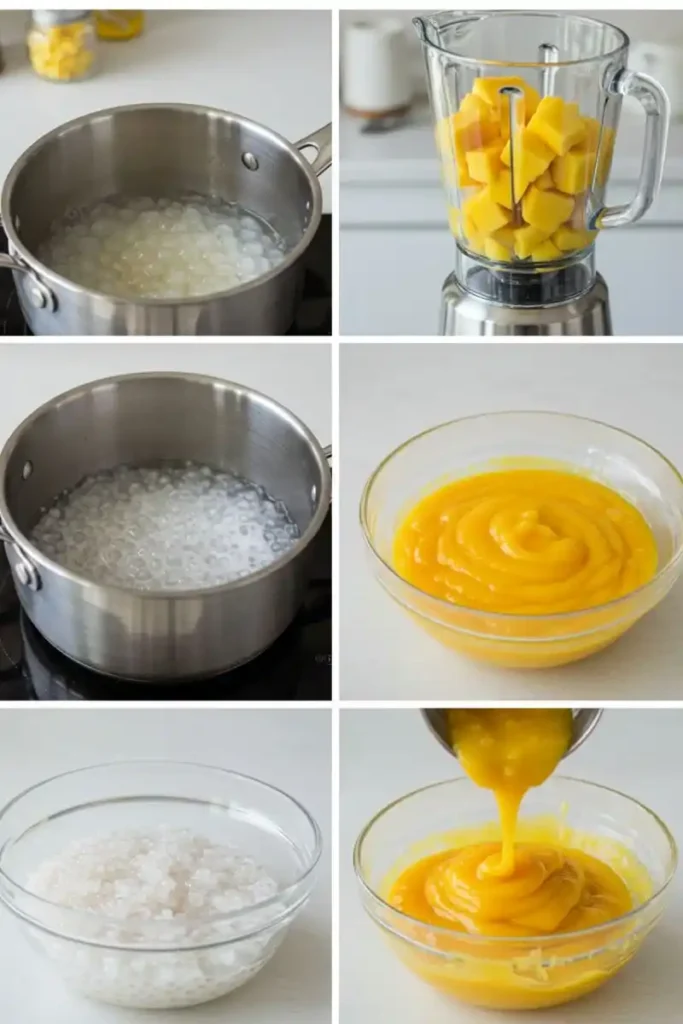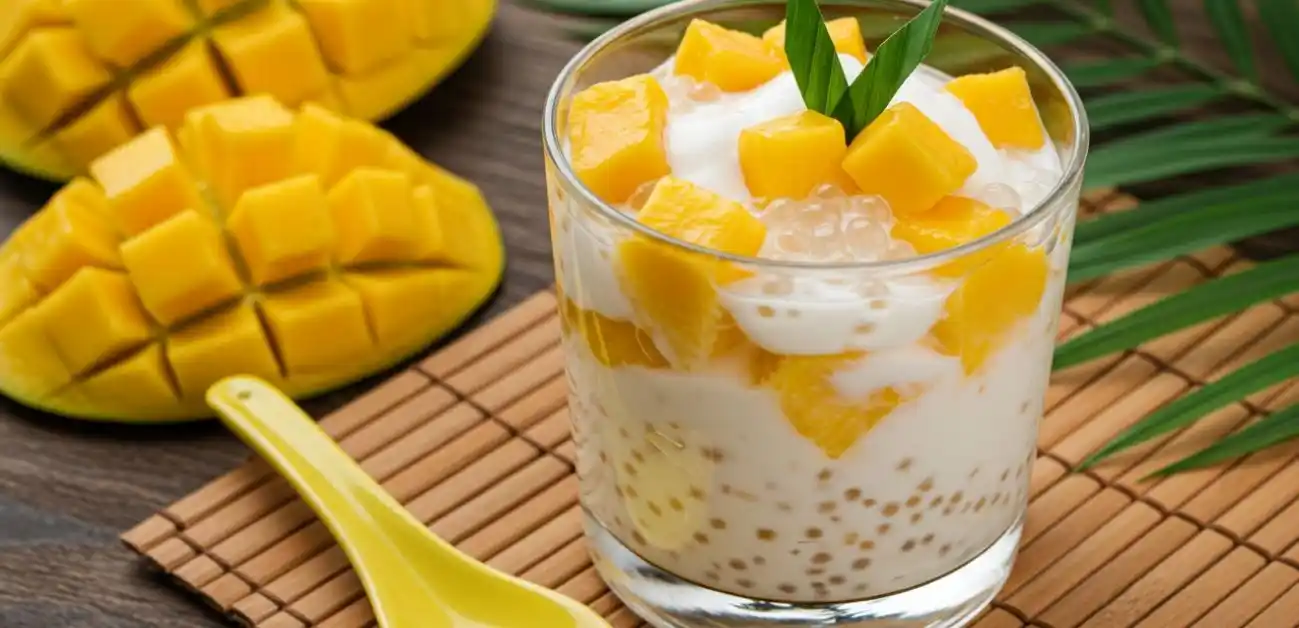There’s something magical about the first spoonful of mango sago dessert—it’s cold, creamy, and just sweet enough to make your eyes light up. For me, this dish is pure sunshine in a bowl. It reminds me of long afternoons in the kitchen with my dad, peeling mangoes until our hands were sticky and laughing over how much sago stuck to the spoon. What I love most? It looks fancy but comes together so simply. If you’re craving something tropical yet light, this mango sago recipe might just become your go-to. Let’s make dessert feel like a little escape.
Mango Sago Dessert Recipe

Mango Sago Dessert Recipe
Equipment
- Medium saucepan (to cook the sago)
- Blender (for pureeing the mango)
- Mixing bowls
- Fine-mesh strainer
- Silicone spatula
Ingredients
- 2 ripe mangoes 1½ blended, ½ diced for garnish
- ½ cup small sago pearls
- 1 cup full-fat coconut milk
- ¼ cup maple syrup or sweetened condensed milk
- 1 cup cold water
- Pinch of salt
- Fresh mint leaves optional, for garnish
Instructions
- Bring 3 cups of water to a boil. Add sago pearls and simmer for 10–15 minutes, stirring occasionally until mostly translucent.
- Drain the sago in a fine mesh strainer and rinse under cold running water to remove excess starch.
- In a blender, combine 1½ mangoes (chopped), coconut milk, sweetener, and a pinch of salt. Blend until smooth and creamy.
- In a bowl, mix the mango puree with the cooked and rinsed sago, along with 1 cup cold water. Stir well.
- Refrigerate for at least 1 hour until chilled.
- Spoon into serving bowls or glasses. Garnish with the remaining diced mango and mint leaves. Serve cold.
Notes
Why I Love This Mango Sago Dessert
Some desserts are fussy. Not this one. Mango sago dessert has that rare balance of being both luxurious and easy—exactly what I reach for on warm days or when friends drop by unexpectedly. It’s creamy without being heavy, fruity without being tart, and best of all, naturally gluten-free and vegetarian. That’s always been important to me as someone who loves to celebrate fresh, whole ingredients. The mango brings a mellow sweetness, while the sago adds that signature chewy bite that’s just fun to eat. Honestly, this is one of those dishes that feels like a treat but fits right into your everyday.
This simple joy reminds me of why I created recipes like the chickpea cottage cheese cookie dough—because indulgence should also feel nourishing.
Why This Mango Sago Dessert is Special
Mango sago dessert is rooted in Asian culinary tradition, but its ingredients and technique are so adaptable that it fits beautifully into modern kitchens. Its origins span across Southeast Asia—Hong Kong, Taiwan, the Philippines—and it’s beloved in each for a reason: the textures. Sago gives this dessert a pearl-like chew that contrasts beautifully with the velvety mango puree. The coconut milk makes it lusciously creamy without the need for dairy or eggs, making it an inclusive option for plant-based eaters.
It’s also endlessly versatile. You can serve it warm or cold, dress it up with toppings like toasted coconut, or keep it classic with just mango. I’ve even paired it with light dishes like this overnight oats guide for a tropical breakfast-for-dessert twist.
Mango Sago Ingredients & Substitutions
The beauty of mango sago lies in its short ingredient list—just a handful of pantry staples and seasonal fruit. But don’t worry, you’ve got options.
| Ingredient | Substitution |
|---|---|
| Mango (Ataulfo, Alphonso) | Canned mango pulp, frozen mango, or ripe peach |
| Sago pearls | Tapioca pearls (similar texture) |
| Coconut milk | Oat milk or almond milk with a splash of coconut extract |
| Maple syrup or condensed milk | Honey, agave, or date syrup |

If you love ingredients that feel indulgent yet healthful, you’ll probably enjoy these gluten-free dessert recipes too.
How to Make This Mango Sago Dessert: Step-by-Step Instructions
This process is simple, but every step adds to the creamy, tropical payoff at the end. Here’s how to nail it:
- Cook the sago: Bring 3 cups of water to a boil in a saucepan. Add sago pearls, stir, and simmer for 10–15 minutes until most turn translucent. Stir often to prevent sticking.
- Rinse and chill: Drain the sago using a fine mesh strainer. Rinse under cold water to stop the cooking. Set aside.
- Make the mango puree: In a blender, combine 1½ mangoes (peeled and chopped), coconut milk, and your sweetener of choice. Blend until smooth and creamy.
- Assemble: In a large bowl, mix the mango puree with the cooled sago and 1 cup cold water. Stir gently to combine.
- Chill: Refrigerate for at least one hour. This step lets the flavors meld and the texture firm up slightly.
- Serve: Spoon into bowls or glasses. Top with reserved diced mango or fresh mint. For a little crunch, try toasted coconut flakes.

It’s a treat that’s just as effortless as our easy Indian vegetarian curry, but sweeter, cooler, and made for warm-weather moments.
Possible Pitfalls & Tips
Even though mango sago is beginner-friendly, there are a few things to watch out for:
1. Overcooking the sago
If your sago turns gummy or disappears completely, it’s likely overcooked. Remove from heat once they’re mostly translucent with a tiny white dot in the center. They’ll finish softening in the rinse.
2. Not rinsing the sago
After cooking, rinse thoroughly under cold water. This removes excess starch that can make your dessert thick and murky rather than silky.
3. Bland mango puree
Use the ripest mangoes you can find. If they aren’t sweet enough, a splash of maple syrup or a few dates blended in will brighten the flavor.
These small tweaks help your dessert shine—just like we do in recipes such as this fluffy oat flour pancake that depends on technique as much as ingredients.
Additional Tips & Variations
Mango sago is incredibly adaptable. Here are ways to personalize it:
- Add texture: Top with toasted coconut, crushed pistachios, or chia seeds.
- Make it vegan: Use maple syrup or agave instead of condensed milk.
- Go extra tropical: Fold in diced pineapple or passion fruit pulp.
- Use it as a parfait base: Layer with coconut yogurt for brunch or dessert.
- Serve warm: Skip the chilling and enjoy right after mixing on a cooler evening.
Pair it with something warm like homemade gluten-free bread for contrast in both texture and temperature.
Expert Tips & Nutrition Highlights
To keep this dish balanced and bright:
- Use full-fat coconut milk: It adds creaminess without needing dairy.
- Keep the portions small: Mango sago is rich, so a small serving satisfies.
- Make ahead: It actually tastes better chilled for several hours.
Nutritional Highlights (Per Serving Estimate)
| Nutrient | Amount |
|---|---|
| Calories | 210 |
| Carbohydrates | 32g |
| Sugar | 14g |
| Fat | 8g |
| Fiber | 2g |
| Protein | 2g |
Mango Sago Dessert FAQ
What is in mango sago dessert?
Mango sago dessert typically includes ripe mangoes, sago pearls, coconut milk, and a sweetener like condensed milk or maple syrup. The combination delivers a creamy, tropical flavor with a slightly chewy texture from the sago.
Is mango sago healthy?
Yes—especially when made at home. Naturally dairy- and gluten-free, it can be lightly sweetened using agave, maple syrup, or your preferred natural sweetener. Plus, mango provides vitamin C and fiber, while coconut milk contributes healthy fats. For a similarly wholesome treat, try this retinol carrot salad for glowing skin.
Is mango sago a Filipino dessert?
While it’s commonly enjoyed in the Philippines, mango sago actually originates from Hong Kong-style cuisine. That said, the tropical flavors make it a perfect fit across Southeast Asian and Pacific Islander food cultures.
How to eat mango sago?
For the best experience, enjoy mango sago cold in a dessert cup or a small serving bowl. You can enjoy it on its own or pair it with light savory meals like vegetarian breakfast recipes or veggie burgers for contrast.
What exactly is sago?
Sago comes from the inner core of certain tropical palm trees, where it’s harvested as a starchy substance. It forms small pearls that become translucent and chewy when cooked—similar in texture to tapioca but made from a different plant source.
What’s the difference between sago and tapioca pudding?
They may look alike in liquid, but tapioca is derived from the cassava plant, whereas sago originates from tropical palm stems. Tapioca pudding is usually dairy-based and more custard-like, while mango sago is lighter, coconut-based, and tropical in flavor.
Final Thoughts on This Mango Sago Dessert
Mango sago dessert is a beautiful mix of tradition and simplicity. It’s naturally gluten-free, incredibly easy to make, and endlessly customizable. Whether you serve it after dinner or as a mid-afternoon cool-down, it brings joy in every creamy, chewy bite. So grab your mangoes and coconut milk—it’s time to turn your kitchen into a tropical escape.
If this recipe brightened your day, you might also love our dairy-free and gluten-free desserts or refreshing smoothie bowl toppings guide.


1 thought on “How to Make Mango Sago Dessert – Easy Asian-Inspired Recipe”